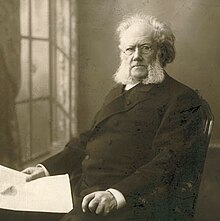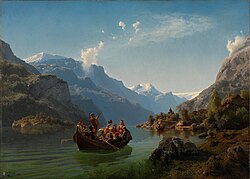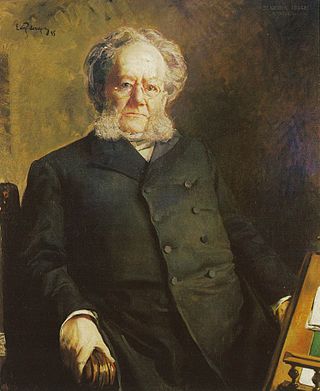
Henrik Johan Ibsen was a Norwegian playwright and theatre director. As one of the founders of modernism in theatre, Ibsen is often referred to as "the father of realism" and the most influential playwright of the 19th century, as well of one of the most influential playwrights in Western literature more generally. His major works include Brand, Peer Gynt, Emperor and Galilean, A Doll's House, Ghosts, An Enemy of the People, The Wild Duck, Rosmersholm, Hedda Gabler, The Master Builder, and When We Dead Awaken. Ibsen is the most frequently performed dramatist in the world after Shakespeare, and A Doll's House was the world's most performed play in 2006.

Oslo is the capital and most populous city of Norway. It constitutes both a county and a municipality. The municipality of Oslo had a population of 709,037 in 2022, while the city's greater urban area had a population of 1,064,235 in 2022, and the metropolitan area had an estimated population of 1,546,706 in 2021.

Skien is a municipality in Telemark county, Norway. It is located in the traditional district of Grenland, although historically it belonged to Grenmar/Skiensfjorden, while Grenland referred the Norsjø area and Bø. The administrative centre of the municipality is the city of Skien, which is also the administrative centre of the whole county. Some of the notable villages in the municipality include Åfoss, Hoppestad, Klovholt, Luksefjell, Melum, Kilebygda, Skotfoss, Sneltvedt, and Valebø.
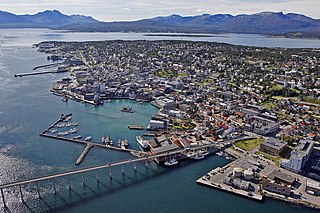
Tromsø is a municipality in Troms county, Norway. The administrative centre of the municipality is the city of Tromsø.

The term neo-romanticism is used to cover a variety of movements in philosophy, literature, music, painting, and architecture, as well as social movements, that exist after and incorporate elements from the era of Romanticism.

The National Museum is a museum in Oslo, Norway which holds the Norwegian state's public collection of art, architecture, and design objects. The collection totals over 400,000 works, amongst them the first copy of Edvard Munch's The Scream from 1893. The museum is state-owned and managed by the Norwegian Ministry of Culture.

Norwegian romantic nationalism was a movement in Norway between 1840 and 1867 in art, literature, and popular culture that emphasized the aesthetics of Norwegian nature and the uniqueness of the Norwegian national identity. A subject of much study and debate in Norway, it was characterized by nostalgia.

Christian Krohg was a Norwegian naturalist painter, illustrator, author and journalist. Krohg was inspired by the realism art movement and often chose motifs from everyday life. He was the director and served as the first professor at the Norwegian Academy of Arts from 1909 to 1925.

The Cemetery of Our Saviour is a cemetery in Oslo, Norway, located north of Hammersborg in Gamle Aker district. It is located adjacent to the older Old Aker Cemetery and was created in 1808 as a result of the great famine and cholera epidemic of the Napoleonic Wars. Its grounds were extended in 1911. The cemetery has been full and thus closed for new graves since 1952, with interment only being allowed in existing family graves. The cemetery includes five sections, including Æreslunden, Norway's main honorary burial ground, and the western, southern, eastern and northern sections. The Cemetery of Our Saviour became the preferred cemetery of bourgeois and other upper-class families. It has many grand tombstones and is the most famous cemetery in Norway.

Norsk Folkemuseum, at Bygdøy, Oslo, Norway, is a museum of cultural history with extensive collections of artifacts from all social groups and all regions of the country. It also incorporates a large open-air museum with more than 150 buildings, relocated from towns and rural districts.
As in many countries, the science, craft, and art of photography in Norway has evolved as a result of changing technology, improving economic conditions, and the level of acceptance of photography as an art form in its own right.

Cinema in Norway has a long history, dating back to the beginning of the 20th century, and has an important stance in European cinema, contributing at least 30 feature-length films a year.
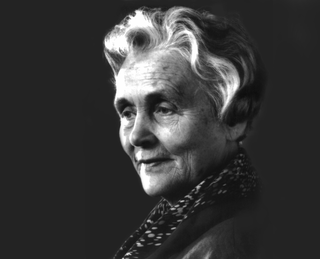
The Arts Council Norway Honorary Award is awarded annually by the Arts Council Norway. The prize is awarded annually to a person who has made a significant contribution to Norwegian art and culture. The prize committee does not solicit nominations and the decision on award is made in closed meeting. Traditionally, no decision basis for the award is announced.

For much of its history Norwegian art is usually considered as part of the wider Nordic art of Scandinavia. It has, especially since about 1100 AD, been strongly influenced by wider trends in European art. After World War II, the influence of the United States strengthened substantially. Due to generous art subsidies, contemporary Norwegian art has a high production per capita.
Events in the year 1949 in Norway.

Hjalmar Eilif Emanuel Peterssen was a Norwegian painter. He is most commonly associated with his landscapes and portraits. He gained early recognition for the history painting Christian II signing the Death Warrant of Torben Oxe and established himself as one of Norway's foremost portrait painters, with portraits of, among others, Henrik Ibsen and Edvard Grieg. He also became known for his landscape paintings, and became part of the artist circle known as the Skagen Painters. He also became known for his design in 1905 of Norway's national coat of arms with the Norwegian lion, which was used by the government and the royal house. The design is still used in the royal coat of arms and the royal flag.

Synnøve Persen is a Norwegian Sámi artist, author, and activist who has played an influential role in bringing Sámi identity to contemporary art. She has been twice nominated for the Nordic Council Literature Prize for the Sami language area for her poetry.
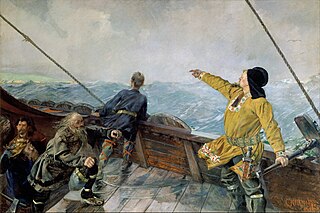
Leiv Eirikson Discovering America is a painting by Christian Krohg. It depicts the explorer Leif Erikson at the moment he discovers American land, as described in the sagas of Icelanders. The painting was made for the Chicago World's Fair in 1893 and was exhibited along with the Viking ship replica Viking. It is in the collection of the National Museum of Art, Architecture and Design in Oslo. A copy of the painting, created by Krohg's son, Per Krohg, has hung in the United States Capitol since 1936.

Alfhild Stormoen was a Norwegian Norwegian actress and director.



